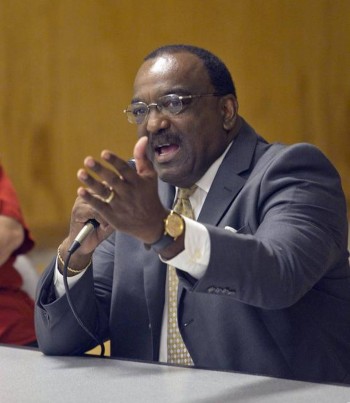We are wondering what happened to this conversation…
___________________________________________________________
There would have been no official black support when the Miami-Dade County Commission endorsed putting a Cuban exile museum on prime county waterfront land if Dennis Moss hadn’t voted yes — with a caveat: Moss, the senior African-American commissioner, said he would vote for the museum celebrating Cuban heritage but that he expected support once he proposed a black history museum.
Recently, Moss took the first step toward that backing when the commission’s Cultural Affairs committee voted unanimously last week to recommend a county study on how to bring a black history museum to the Miami waterfront. But the particulars of Moss’ proposal — instructing Mayor Carlos Gimenez to explore using tax dollars for construction — promises to inject more tension into the already delicate task of prioritizing Miami-Dade’s cultural institutions.
Organizers of the Cuban exile museum made a point of insisting they would never seek public dollars for their proposed $125 million facility on county-owned land behind AmericanAirlines Arena, saying they could raise enough money from people of Cuban heritage around the world, particularly those with significant fortunes.
In rejecting that approach, Moss is pointing to both the prosperity divide between the Cuban and black communities, and the tax support Miami-Dade gives to local museums backed by two of Miami’s wealthiest citizens. Moss noted commissioners already approved more than $200 million to build the Pérez Art Museum Miami and Frost science museum named for, respectively, condo developer Jorge Pérez and Phillip Frost, a medical-research mogul, and his wife, Patricia.
“There is significant county support for those museums,†Moss, a five-term commissioner, said in an interview. “I don’t see a black history museum being treated any differently.â€
Last week, Pérez led a delegation to County Hall seeking the additional $1.4 million for PAMM that Gimenez initially put in his proposed 2015 budget, but later dropped in order to shift the funds to the police budget. The group met with Rebeca Sosa, the commission’s chairwoman and an opponent of the plan to increase PAMM’s funding beyond the annual $2.5 million in hotel taxes it already receives. Sosa said she told the group she couldn’t support the request “when I’m trying to find funding for police and other county services.†A PAMM spokeswoman declined to comment.
The PAMM funding question should come to a head this month, with the commission’s first budget hearing scheduled for 5 p.m. Thursday and a final vote on the $6.2 billion budget needed before the fiscal year ends Sept. 30. And while it will likely be weeks before commissioners take up the issue of a black history museum, the PAMM debate adds another wrinkle to the Moss request.
The concept of a black history museum received strong encouragement from fellow commissioners on July 17 when Moss linked his Cuban museum support to the commission also endorsing a black history museum. But with county funding now in the equation, Moss can’t count on an easy win.
“If he’s exploring public dollars to build, that’s not what the Cuban museum did,†said Commissioner Esteban “Steve†Bovo, the sponsor of the exile museum ordinance. “I’m going to hold everyone to the same standard.â€
The Moss resolution heading to the full County Commission this fall only calls for exploring the use of tax dollars for the black history museum, and recommends having voters first endorse borrowing the money to build it.
Moss listed three possible sites: Miami’s Museum Park, near the planned location of the exile museum; Watson Island, home to the Miami Children’s Museum; and the southwest corner of Port Miami, where David Beckham wanted to build a soccer stadium until commissioners voted to block it. Of the three sites, Miami-Dade County controls only the port.
The Moss-sponsored resolution that the four-member Cultural Affairs panel passed unanimously Thursday echoed comments Moss made during the exile museum vote: black immigrants played a central role in Miami-Dade’s history and deserve as much celebration as any community.
According to the resolution, “this County was developed by black people who, while dreamers, made up the bulk of the pioneer labor force that helped make this County into the thriving metropolis it is today.†It noted that black residents provided labor for Henry Flagler’s railroad, construction of Miami Beach hotels, the Vizcaya mansion and the original Dade County Courthouse.
Moss’ resolution came less than two months after the commission finally agreed to the concept of a Cuban exile museum on county-owned waterfront land. On July 17, the full commission voted 8-3 to endorse a home for the Cuban exile museum. That decision followed years of debate and false starts, including a similar route of commissioners asking Gimenez to study the issue. The vote didn’t divide the commission by race or ethnicity: Xavier Suarez, who served as Miami’s first Cuban-born mayor before winning a county seat, joined two black commissioners, Audrey Edmonson and Barbara Jordan, in voting against it.
And while commissioners instructed Gimenez to negotiate a deal with exile museum organizers, the commission would still need to approve any plan to actually build the museum on the county-owned land known as Parcel B. Nicolás Gutiérrez, an organizer of the exile museum, said last week his group welcomes the Moss effort.
“To the extent we can be supportive in any way, we’re happy to do so. We agree they deserve their own museum, and we wish them the best,†he said. “They’re obviously free to use whatever approach they think is best.â€
Moss said it’s not fair to hold a black history museum to the financial pledge made by the exile museum, given the economic disparity between the two. “You’re looking at an African-American community that doesn’t have the resources of the Cuban community,†Moss said. “They’re better positioned to do the museum themselves.â€
His resolution calls for the Black Archives, a Miami-based research and heritage nonprofit, to develop the new museum, which would house the archives’ extensive collection of historical memorabilia and materials. The organization owns and operates some of Miami’s top historic sites related to black history, including the Lyric Theater, once a magnet for the nation’s top black performers, and the Dr. Samuel Johnson X-Ray Clinic, which opened in 1939 to treat black residents denied treatment in Miami’s segregated hospital system.
Timothy Barber, director of the archives, said he was asked to get involved with Ross’ effort after the exile museum vote. He sees the museum as a way to showcase Miami’s black heritage in a high-profile location popular with tourists.
“It would allow us to serve as a gateway for this community,†he said from the archives office in the Joseph Caleb center near Brownsville.
“It’s difficult to get people to come to these communities, particularly with the negative stigma the media has put some of these neighborhoods, like Overtown. That’s why you have the Pérez and the Frost and the AmericanAirlines Arena there,†he continued. “The arena was in Overtown, but it closed to move to the waterfront.â€


